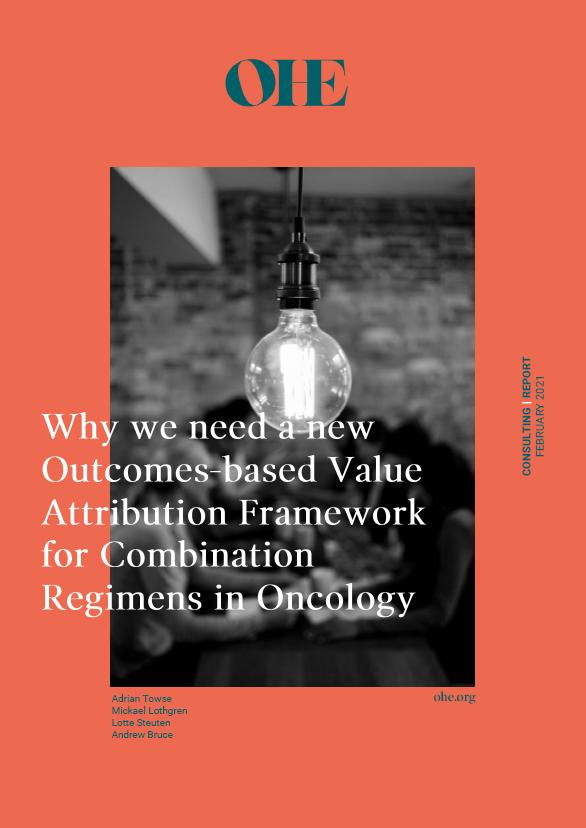Sign up to our newsletter Subscribe
Analysing Global Immunisation Expenditure

Using medicines in combination can deliver better outcomes for patients across different tumour types and disease stages. Yet many HTA agencies do not find that the expected additional benefits from adding a new medicine to a currently reimbursed medicine represents value for money to the health system. In markets that utilise cost-per-QALY approaches for assessing value, a clinically effective medicine might even be found to be “not cost-effective at zero price” when used as part of a regimen that increases treatment duration.
Using medicines in combination can deliver better outcomes for patients across different tumour types and disease stages. Yet many HTA agencies do not find that the expected additional benefits from adding a new medicine to a currently reimbursed medicine represents value for money to the health system. In markets that utilise cost-per-QALY approaches for assessing value, a clinically effective medicine might even be found to be “not cost-effective at zero price” when used as part of a regimen that increases treatment duration.
This counter-intuitive phenomenon of “not cost-effective at zero price” has spurred recent efforts to understand both the root causes of the problem, what actually needs to be solved, and by whom.
This publication by authors from OHE (Adrian Towse and Lotte Steuten) and Amgen (Mickael Lothgren and Andrew Bruce) contributes to the emerging debate as to why a new approach is required to address the value attribution problem in combination treatments. It sets out two key concepts required for an understanding of the relative performance of a combination regimen as compared to a monotherapy, considering (i) additive scale (how much additional value is generated when compared with their independent use as monotherapies) and (ii) the relative change in treatment duration as compared to the relative increase in overall survival.
Combinations usually have an increase in treatment duration relative to overall survival that is at least proportional to that of the monotherapy, and HTA approaches usually assume the backbone therapy is able to maintain its price in the new combination regimen indication. The result is treatments that are “not cost-effective at zero price.” The conceptual framework shows that two new approaches – the partial information incremental value approach, and the full information monotherapy ratio approach – are only comparable if we make an implicit assumption about additivity that is unlikely to hold in most cases. Most combinations have sub-additive scale – that is, the sum of the health gain provided by the two separate monotherapies is greater than that of monotherapy but less than the health gain provided by the two treatments when used in the combination regimen.
Overall, we need an approach that is able to combine the best features of the two approaches (the partial information incremental value approach, and the full information monotherapy ratio approach); i.e., it should recognise the contribution of each product as a monotherapy, and also recognise their respective contributions to the combination regimen.
This brings us to the issue of what general principles we might expect an attribution mechanism to meet. The report argues that for value attribution, rules that are:
While a solution to the Value Attribution Problem will not in itself fully resolve the broader policy challenge, it is, in our view, a critical prerequisite for solving the other problems, including the competition law problem (enabling competitor companies to legally negotiate and arrive at “agreed” prices for the constituent medicines within a regimen, so that the total cost of the latter is commensurate with the value of the treatment) and the incentive problem (there is a strong disincentive for the owner of a backbone medicine to renegotiate on price in combination use, should that adjusted price flow on to all reimbursed uses of that medicine). The latter problem will, in many markets, require the adoption of some form of indication or multi-use pricing. A valid value attribution process will help to enable this. Therefore, it is in our view essential that HTA bodies and/or payers involve themselves in the development of a value attribution framework.
Our paper was stimulated in part by the Bellberry process which led to a workshop in November 2019 and a follow up report, with peer reviewed publications in the pipeline. We are also aware of the work initiated by Takeda, under the direction of an Advisory Group led by Eric Low, to address both the value attribution issue and the process by which manufacturers are able to enter negotiations that can help navigate anti-trust rules designed to prevent price collusion. A session was held at ISPOR Milan led by Andrew Briggs, and two reports are expected to be launched very shortly.
We look forward to working with our Amgen co-authors, those involved in the Bellberry discussions, the Takeda project, and others on ways in which these issues can be progressed.
Citations:
Towse, A., Lothgren, M., Steuten, L., and Bruce, A., 2021. Why we need a new Outcomes-based Value Attribution Framework for Combination Regimens in Oncology. OHE Consulting Report, London: Office of Health Economics. Available at: https://www.ohe.org/publications/why-we-need-new-outcomes-based-value-attribution-framework-combination-regimens
Why we need a new Outcomes-based Value Attribution Framework for Combination Regimens in Oncology

